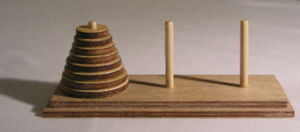Tower of Hanoi puzzle
From Psy3241
| Line 2: | Line 2: | ||
The Tower of Hanoi is a mathematical puzzle which consists of three pegs and a number of pegs | The Tower of Hanoi is a mathematical puzzle which consists of three pegs and a number of pegs | ||
| - | laying on one of the pegs in the order of largest to smallest from bottom to top. The object | + | laying on one of the pegs in the order of largest to smallest from bottom to top. The object |
of the puzzle is to move all the pegs from one peg on one side to the third peg opposite the | of the puzzle is to move all the pegs from one peg on one side to the third peg opposite the | ||
original one. However, you have to obey three specific rules: | original one. However, you have to obey three specific rules: | ||
| Line 14: | Line 14: | ||
There is a legend about an Indian temple which contains a large room with three time-worn posts in it surrounded by 64 golden disks. The priests of Brahma, acting out the command of an ancient prophecy, have been moving these disks, in accordance with the rules of the puzzle. According to the legend, when the last move of the puzzle is completed, the world will end. It was created by a French mathematician Édouard Lucas in 1883. | There is a legend about an Indian temple which contains a large room with three time-worn posts in it surrounded by 64 golden disks. The priests of Brahma, acting out the command of an ancient prophecy, have been moving these disks, in accordance with the rules of the puzzle. According to the legend, when the last move of the puzzle is completed, the world will end. It was created by a French mathematician Édouard Lucas in 1883. | ||
[[Image:Tower_of_hanoi.jpg]] | [[Image:Tower_of_hanoi.jpg]] | ||
| + | |||
| + | == Applications== | ||
| + | The Tower of Hanoi is frequently used in psychological research on problem solving. Along with this it is also used as a memory test by neuropsychologists trying to evaluate amnesia. | ||
Revision as of 00:43, 25 April 2008
The Tower of Hanoi is a mathematical puzzle which consists of three pegs and a number of pegs
laying on one of the pegs in the order of largest to smallest from bottom to top. The object
of the puzzle is to move all the pegs from one peg on one side to the third peg opposite the
original one. However, you have to obey three specific rules:
1. Only one disk may be moved at a time.
2. Each move consists of taking the upper disk from one of the pegs and sliding it onto another peg, on top of the other disks that may already be present on that peg.
3. No disk may be placed on top of a smaller disk.
Origin
There is a legend about an Indian temple which contains a large room with three time-worn posts in it surrounded by 64 golden disks. The priests of Brahma, acting out the command of an ancient prophecy, have been moving these disks, in accordance with the rules of the puzzle. According to the legend, when the last move of the puzzle is completed, the world will end. It was created by a French mathematician Édouard Lucas in 1883.

Applications
The Tower of Hanoi is frequently used in psychological research on problem solving. Along with this it is also used as a memory test by neuropsychologists trying to evaluate amnesia.

